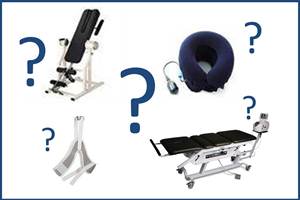Chiropractic traction (also called “vertebral traction”, “spinal traction” or “cervical traction”) is one of the most widely used and accepted treatments for spinal, muscle and skeletal pain is.
The term “traction” applies to the use of weights and other forces to treat skeletal and muscular disorders, pinched or compressed nerves and injuries to the joints, vertebrae, muscles and ligaments by stretching the muscles and ligaments and increasing the space between vertebrae. Chiropractic traction may also help to relieve the pain caused by herniated or bulging discs or by disc degenerative disorders. 
There are two main types of chiropractic traction: manual and mechanical. The choice of traction depends on the amount of force necessary to provide a sufficient weight and pressure distraction. With manual traction, the chiropractor applies gentle manual pressure and tension (i.e., traction) to the patient’s limbs and head to stretch the muscles and skeleton, and can even use the patient’s own weight to provide additional traction, a technique known as inversion therapy.
When more force is needed than can be provided with regular manual traction, the chiropractor employs more complex cervical traction systems. Traction tables can apply continuous or intermittent traction while combining heat, vibration and massage. These tables can also be computer-controlled so as to provide exact pressure and apply appropriately gentle variations in pressure. One of the advantages of mechanical traction is that in many cases the patient can continue the therapy with the use of home traction units. Once the patient has been instructed on the proper use of these home devices, the patient can improve their own posture and spinal alignment by regular use of these machines. However, home traction should not be performed without a doctor’s approval and should preferably be supervised by a qualified therapist.
Both forms of traction are helpful for reducing or relieving the constant pressure that certain muscle groups and parts of the skeleton endure, either from normal day-to-day living or from injuries and disease. Chiropractic therapeutic traction is not appropriate for patients with serious bone conditions such as osteoporosis, osteomyelitis and bone cancer, or with heart disease and spinal cord diseases. It is also not appropriate for those with spinal fractures or arthritis. However, for patients whose conditions are due to spinal issues, minor to moderate muscle spasms, over- or under-stressed muscles and joints and minor injuries, chiropractic traction may provide short-term pain relief (this may be especially true for sciatica patients), increased vascular and lymphatic flow, increased muscle tone (flexibility and strength) and balance.
Remember that this type of treatment should only be considered following careful examination and diagnosis, and that it should be professionally supervised to ensure safety and effectiveness. If you’re wondering whether some form of traction might be appropriate for you, please contact our office for an appointment.
